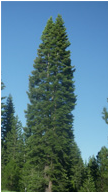 The sugar pine, scientifically known as the pinus lambertiana and also commonly referred to as the sugar cone pine, is the tallest and most massive pine tree. Native to the mountains of the Pacific Coast California to Baja California, it has the longest cones of any conifer.
The sugar pine, scientifically known as the pinus lambertiana and also commonly referred to as the sugar cone pine, is the tallest and most massive pine tree. Native to the mountains of the Pacific Coast California to Baja California, it has the longest cones of any conifer.
These trees commonly grow to heights of between 130 feet and 195 feet, on occasion to 260 feet, with typical trunk diameters from 4 feet 11 in to 8 feet 2 inches, exceptionally to 11 feet 6 inches. The tallest recorded specimen, located in Yosemite National Park, is 273 feet 9 inches tall,and was discovered in 2015. The second tallest recorded was “Yosemite Giant,” a 269 feet 2 inch tall specimen also in Yosemite. It died from a bark beetle attack in 2007.
Pinus lambertiana is a member of the white pine group, Pinus subgenus Strobus, and, like all members of that group, has leaves, i.e., needles, which grow in fascicles, i.e., bundles of five, with a deciduous sheath. They are 2 1⁄4 to 4 1⁄4 inches long. Sugar pine cones are generally 9 3⁄4 inches –19 3⁄4 inches long, exceptionally reaching 26 inches long, although the cones of the Coulter pine are heavier. The seeds are 13⁄32 inches to 15⁄32 inches long, with a 3⁄4 inch to 1 1⁄8-inch long wing that aids their dispersal by wind. The seeds of the sugar pine are also a type of edible pine nut.
The sugar pine has been severely affected by the white pine blister rust (Cronartium ribicola), a fungus that was accidentally introduced from Europe in 1909. A high proportion of sugar pines has been killed by the blister rust, particularly in the northern part of the species’ range that has experienced the rust for a longer period of time. The rust has also destroyed much of the western white pine and whitebark pine throughout their ranges. The U.S. Forest Service has a program for developing rust-resistant sugar pine and western white pine. Seedlings of these trees have been introduced into the wild. The Sugar Pine Foundation in the Lake Tahoe Basin has been successful in finding resistant sugar pine seed trees and has demonstrated that it is important for the public to assist the U.S. Forest Service in restoring this species. However, blister rust is much less common in California, and Sugar, Western White and Whitebark pines still survive in great numbers there.
Naturalist John Muir considered sugar pine to be the “king of the conifers.” The common name comes from the sweet resin, which Native Americans used as a sweetener. John Muir found it preferable to maple sugar. It is also known as the great sugar pine. The scientific name was assigned by David Douglas in honor of Aylmer Bourke Lambert.
The Washo language has a word for sugar pine, simt’á:gɨm, and also a word for “sugar pine sugar,” nanómba.
In the Achomawi creation myth, Annikadel, the creator, makes one of the ‘First People’ by intentionally dropping a sugar pine seed in a place where it can grow. One of the descendants in this ancestry is Sugarpine-Cone man, who has a handsome son named Ahsoballache.
After Ahsoballache marries the daughter of To’kis the Chipmunk-woman, his grandfather insists that the new couple have a child. To this end, the grandfather breaks open a scale from a sugar pine cone, and secretly instructs Ahsoballache to immerse the scale’s contents in spring water, then hide them inside a covered basket. Ahsoballache performs the tasks that night; at the next dawn, he and his wife discover the infant Edechewe near their bed
From Wikipedia and www.confiers.org
SBCSentinel
News of note from around the largest county in the lower 48 states.
